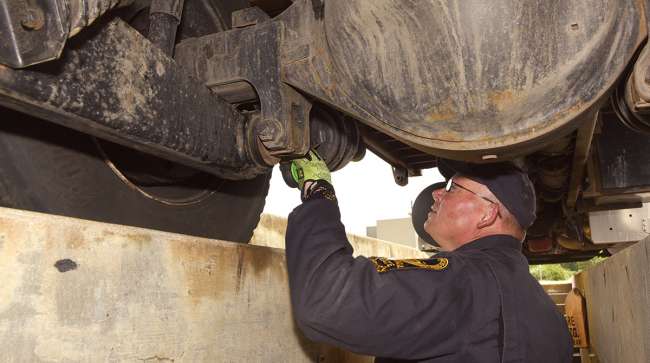Senior Reporter
CVSA Brake Safety Week Scheduled for Aug. 21-27

[Stay on top of transportation news: Get TTNews in your inbox.]
Commercial motor vehicle inspectors will be conducting this year’s Brake Safety Week from Aug. 21-27, the Commercial Vehicle Safety Alliance announced June 7.
Brake Safety Week is an annual commercial motor vehicle brake safety inspection, enforcement and education initiative conducted by law enforcement jurisdictions in Canada, Mexico and the United States.
During Brake Safety Week, inspectors will conduct their usual North American Standard Level I and V Inspections and capture and report brake-related data to CVSA. This year’s focus will be on total inspections and brake-related out-of-service violations, and inspectors also will capture and provide data on brake hose/tubing chafing violations.
The results will not be released until fall.
Brake-related violations account for the largest percentage of all out-of-service vehicle violations cited during roadside inspections. During last year’s three-day International Roadcheck data, brake systems and brake adjustment violations accounted for 38.9% of all vehicle out-of-service violations — the most of any category of vehicle violations.
CVSA has announced Aug. 21-27 as the dates for this year’s Brake Safety Week. Brake Safety Week is an annual CMV brake-safety inspection, enforcement and education initiative conducted by law enforcement jurisdictions in Canada, Mexico and the U.S. https://t.co/R08kU6BAJK pic.twitter.com/jofVOtH1Ld — CVSA (@CVSA) June 7, 2022
To prepare for the event, CVSA recommends that motor carriers conduct proactive vehicle maintenance in advance of the week, and reminds drivers and carriers about the importance of proper brake maintenance and vehicle pre-trip and post-trip inspections.
The event provides an opportunity for outreach and educational brake safety efforts by inspectors, CVSA said.
During the brake portion of a vehicle inspection, inspectors will look for missing, nonfunctioning, loose, contaminated or cracked parts on the brake system, and nonmanufactured holes (such as rust holes and holes created by rubbing or friction) and broken springs in the spring brake housing section of the parking brake.
They also will listen for audible air leaks around brake components and lines, and ensure the air system maintains air pressure between 90-100 psi.
Inspectors will also check for S-cam flip-over and measure pushrod travel, and that slack adjusters are the same length from center of S-cam to center of clevis pin, and air chambers on each axle are the same size.
In addition, they will inspect required brake-system warning devices, such as ABS malfunction lamps and low air-pressure warning devices and ensure the breakaway system is operable on the trailer as well as inspect the tractor protection system, including the bleed-back system on the trailer.
“Poorly maintained brake systems can reduce the braking capacity and stopping distance of large trucks and motorcoaches, which poses a serious risk to driver and public safety,” said the CVSA president, Capt. John Broers with the South Dakota Highway Patrol. “In those split-second emergency situations, the proper functionality of the brake systems on large commercial motor vehicles is crucial.”
Want more news? Listen to today's daily briefing below or go here for more info:




